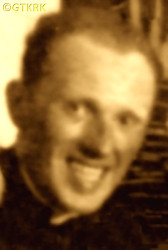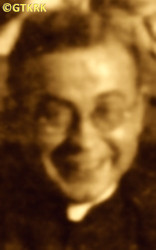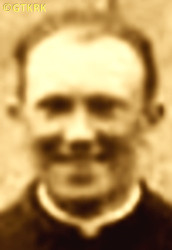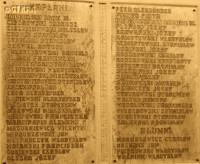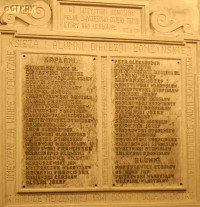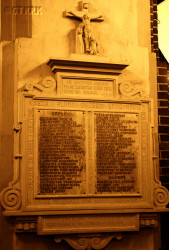Roman Catholic
St Sigismund parish
05-507 Słomczyn
85 Wiślana Str.
Konstancin deanery
Warsaw archdiocese, Poland
full list:
displayClick to display full list

searchClick to search full list by categories
wyświetlKliknij by wyświetlić pełną listę po polsku

szukajKliknij by przeszukać listę wg kategorii po polsku

Martyrology of the clergy — Poland
XX century (1914 – 1989)
personal data
surname
PĘZA
forename(s)
Alexander (pl. Aleksander)
function
diocesan priest
creed
Latin (Roman Catholic) Church RCmore on
en.wikipedia.org
[access: 2014.09.21]
diocese / province
Łomża diocesemore on
www.kuria.lomza.pl
[access: 2012.11.23]
RC Military Ordinariate of Polandmore on
en.wikipedia.org
[access: 2014.12.20]
honorary titles
„Cross of Valour”more on
„Cross of Valour”
date and place
of death
15.07.1943

Kosówka foresttoday: Rajgród gm., Grajewo pov., Podlaskie voiv., Poland
more on
en.wikipedia.org
[access: 2022.01.28]
alt. dates and places
of death
15.08.1941
details of death
After German and Russian invasion of Poland in 09.1939 and start of the World War II, after start of Russian occupation — Grajewo was captured by the Germans on 07.09.1939 but on 28.09.1939 was handed over to the Russians in accordance with Ribbentrop–Molotov accords — clandestinely educated, together with his parish priest, Fr Stanislav Wyszyński, children and youth.
Organised resistance (the genocidal NKVD started investigation of both clerics under „Bell” name, accusing them of „encouraging young people to join insurgent units and conduct armed struggle against the occupant”) — in 1940–1941, the Russians carried out three deportations of Poles into the depths of Russia („to Siberia”) and to the Russian Gulag concentration camps.
After German attack on 22.06.1941 of their erstwhile ally, Russians, and start of German occupation, publicly opposed the lynching of Jews who collaborated with the Russians during the Russian occupation by the Poles — c. 10 Jews were killed in pogrom.
Active as chaplain of the clandestine Polish resistance organization Armed Struggle Union ZWZ, reformed into Home Army AK (part of Polish Clandestine State) under nom‐de‐guerre „Falcon”.
Was also chaplain of one of Polish partisan units.
Helped in hiding Jews (among them Dr Sigismund/Zalmon Szejtelman) — Germans liquidated Grajewo ghetto on 02.11.1942.
Arrested by the Germans in 06.1943 after publicly calling to refuse to participate in anti‐Jewish provocations.
Murdered in a mass execution with a number of victims from Grajewo — part of German extermination plan of Polish intelligentsia of Białystok region, called «Black July» 1943.
cause of death
mass murder
perpetrators
Germans
sites and events
Kosówka forestClick to display the description, «Black July» 1943Click to display the description, Help to the JewsClick to display the description, Ribbentrop‐MolotovClick to display the description, Pius XI's encyclicalsClick to display the description
date and place
of birth
06.02.1910Birth certification on:
metryki.genealodzy.pl
[access: 2025.03.16]

Porośl‐Kijetoday: Sokoły gm., Wysokie Mazowieckie pov., Podlaskie voiv., Poland
more on
en.wikipedia.org
[access: 2022.01.28]
parents
PĘZA Joseph
🞲 ?, ? — 🕆 ?, ?

RZĄCA Constance
🞲 ?, ? — 🕆 ?, ?
baptism
07.02.1910Birth certification on:
metryki.genealodzy.pl
[access: 2025.03.16]

Sokołytoday: Sokoły gm., Wysokie Mazowieckie pov., Podlaskie voiv., Poland
more on
en.wikipedia.org
[access: 2021.08.06]
Assumption of the Blessed Virgin Mary RC church
presbyter (holy orders)
ordination
22.05.1937

Łomżatoday: Łomża city pov., Podlaskie voiv., Poland
more on
en.wikipedia.org
[access: 2022.01.28]
positions held
1938 – 1943
vicar — Grajewotoday: Grajewo urban gm., Grajewo pov., Podlaskie voiv., Poland
more on
en.wikipedia.org
[access: 2022.01.28] ⋄ Holy Trinity RC parish ⋄ Grajewotoday: Grajewo urban gm., Grajewo pov., Podlaskie voiv., Poland
more on
en.wikipedia.org
[access: 2022.01.28] RC deanery — also: prefect of elementary schools
1937 – 1938
vicar — Lachowotoday: Kolno gm., Kolno pov., Podlaskie voiv., Poland
more on
en.wikipedia.org
[access: 2022.08.05] ⋄ Annunciation to the Blessed Virgin Mary RC parish ⋄ Kolnotoday: Kolno urban gm., Kolno pov., Podlaskie voiv., Poland
more on
pl.wikipedia.org
[access: 2021.12.18] RC deanery
1932 – 1937
student — Łomżatoday: Łomża city pov., Podlaskie voiv., Poland
more on
en.wikipedia.org
[access: 2022.01.28] ⋄ philosophy and theology, Theological Seminary
others related
in death
WYSZYŃSKIClick to display biography Stanislav, BESZTA–BOROWSKIClick to display biography Anthony, BURAKClick to display biography Mark, KLIMCZAKClick to display biography Michael Eugene (Fr Dennis), KOCHANOWSKIClick to display biography Felix, KOZŁOWSKIClick to display biography Joseph, KUŹMICKIClick to display biography Witold, OLSZEWSKIClick to display biography Louis, OPIATOWSKIClick to display biography Henry, PŁOŃSKIClick to display biography Joseph, ROSZAKClick to display biography Edmund, RUTKOWSKIClick to display biography Bronislav, SKOKOWSKIClick to display biography Justin, SZULCClick to display biography Joseph, SZYPIŁŁOClick to display biography Casimir
sites and events
descriptions
Kosówka forest: In the forest n. Prostki and Bogusze, c. 5 km from Grajewo — not far from a series of POW camps set up after German attack on 21.06.1941 of their erstwhile ally, Russians (Stalag I E, Stalag I F/Z, Stalag I B/PR, Stalag 373 and Oflag 56) — Germans during genocidal extermination of Polish intelligentsia known as „«Black July» 1943” murdered on 15.07.1943 in a mass execution approx. 150 Poles. Among them were member of Polish resistance movement (part of Polish Clandestine State). The „Kosówka” forest was also a place of mass murders of aforementioned POWs. Also later a number of mass murders took place there, among others on 20.01.1945 when c. 120 Poles were executed there. (more on: historialomzy.plClick to attempt to display webpage
[access: 2013.08.17])
«Black July» 1943: On 20.05.1943 East Prussia German Germ. Gauleiter (Eng. regional leader), Erich Koch, nominated Otton Helwig a new German commander of SS und Polizeiführer (Eng. SS and police commander) of Bezirk (Eng. region) Białystok. He immediately initiated a pacification action ostensibly targeted at Polish partisans. The real aim was intimidation of the Poles from Białystok region and extermination of its leading classes. Herbert Zimmermann, security police and SD commanded, deputy commander of Einsatzgruppen SS (Eng. Operational Groups) for Germ. Bezirk (district) Bialystok, issued an order to arrest and execute 19 people, physicians, barristers, city staff and teacher, including their families, in each all county cities of the district. On 10.07.1943 a „Commando Müller” (from the surname of its murderous commander, prob. Hermann Müller), consisting of Belarus support batallion, Lithuanian units dressed in German uniforms, German Gendarmerie and police and German Gestapo members, perpetrated a series of mass murders in various places in Bezirk Białystok (including its Łomża and Grodno regions). In 07.1943 Germans murdered more than 1,000 people (prob. near 2,000). On 15.07.1943 only in all county seats of Bezirk Bialystok at least 9 local Polish intelligentsia families, including women, children and old were selected and murdered. Among the victims were many priests: in executions in Pilice forest, Wiszownik forest, Kosówka forest, Navumavichy, Jeziorka, etc. Germans murdered at least 15 clerics. (more on: www.swzygmunt.knc.plClick to attempt to display webpage
[access: 2019.10.13])
Help to the Jews: During World War II on the Polish occupied territories Germans forbid to give any support to the Jews under penalty of death. Hundreds of Polish priests and religious helped the Jews despite this official sanction. Many of them were caught and murdered.
Ribbentrop‐Molotov: Genocidal Russian‐German alliance pact between Russian leader Joseph Stalin and German leader Adolf Hitler signed on 23.08.1939 in Moscow by respective foreign ministers, Mr. Vyacheslav Molotov for Russia and Joachim von Ribbentrop for Germany. The pact sanctioned and was the direct cause of joint Russian and German invasion of Poland and the outbreak of the World War II in 09.1939. In a political sense, the pact was an attempt to restore the status quo ante before 1914, with one exception, namely the „commercial” exchange of the so‐called „Kingdom of Poland”, which in 1914 was part of the Russian Empire, fore Eastern Galicia (today's western Ukraine), in 1914 belonging to the Austro‐Hungarian Empire. Galicia, including Lviv, was to be taken over by the Russians, the „Kingdom of Poland” — under the name of the General Governorate — Germany. The resultant „war was one of the greatest calamities and dramas of humanity in history, for two atheistic and anti‐Christian ideologies — national and international socialism — rejected God and His fifth Decalogue commandment: Thou shall not kill!” (Abp Stanislav Gądecki, 01.09.2019). The decisions taken — backed up by the betrayal of the formal allies of Poland, France and Germany, which on 12.09.1939, at a joint conference in Abbeville, decided not to provide aid to attacked Poland and not to take military action against Germany (a clear breach of treaty obligations with Poland) — were on 28.09.1939 slightly altered and made more precise when a treaty on „German‐Russian boundaries and friendship” was agreed by the same murderous signatories. One of its findings was establishment of spheres of influence in Central and Eastern Europe and in consequence IV partition of Poland. In one of its secret annexes agreed, that: „the Signatories will not tolerate on its respective territories any Polish propaganda that affects the territory of the other Side. On their respective territories they will suppress all such propaganda and inform each other of the measures taken to accomplish it”. The agreements resulted in a series of meeting between two genocidal organization representing both sides — German Gestapo and Russian NKVD when coordination of efforts to exterminate Polish intelligentsia and Polish leading classes (in Germany called «Intelligenzaktion», in Russia took the form of Katyń massacres) where discussed. Resulted in deaths of hundreds of thousands of Polish intelligentsia, including thousands of priests presented here, and tens of millions of ordinary people,. The results of this Russian‐German pact lasted till 1989 and are still in evidence even today. (more on: en.wikipedia.orgClick to attempt to display webpage
[access: 2015.09.30])
Pius XI's encyclicals: Facing the creation of two totalitarian systems in Europe, which seemed to compete with each other, though there were more similarities than contradictions between them, Pope Pius XI issued in 03.1937 (within 5 days) two encyclicals. In the „Mit brennender Sorge” (Eng. „With Burning Concern”) published on 14.03.1938, condemned the national socialism prevailing in Germany. The Pope wrote: „Whoever, following the old Germanic‐pre‐Christian beliefs, puts various impersonal fate in the place of a personal God, denies the wisdom of God and Providence […], whoever exalts earthly values: race or nation, or state, or state system, representatives of state power or other fundamental values of human society, […] and makes them the highest standard of all values, including religious ones, and idolizes them, this one […] is far from true faith in God and from a worldview corresponding to such faith”. On 19.03.1937, published „Divini Redemptoris” (Eng. „Divine Redeemer”), in which criticized Russian communism, dialectical materialism and the class struggle theory. The Pope wrote: „Communism deprives man of freedom, and therefore the spiritual basis of all life norms. It deprives the human person of all his dignity and any moral support with which he could resist the onslaught of blind passions […] This is the new gospel that Bolshevik and godless communism preaches as a message of salvation and redemption of humanity”… Pius XI demanded that the established human law be subjected to the natural law of God , recommended the implementation of the ideal of a Christian state and society, and called on Catholics to resist. Two years later, National Socialist Germany and Communist Russia came together and started World War II. (more on: www.vatican.vaClick to attempt to display webpage
[access: 2023.05.28], www.vatican.vaClick to attempt to display webpage
[access: 2023.05.28])
sources
personal:
www.glaukopis.plClick to attempt to display webpage
[access: 2012.11.23], www.grajewiak.plClick to attempt to display webpage
[access: 2013.08.17], metryki.genealodzy.plClick to attempt to display webpage
[access: 2025.03.16], historialomzy.plClick to attempt to display webpage
[access: 2013.08.17]
original images:
grajewiak.plClick to attempt to display webpage
[access: 2020.09.27], slideplayer.plClick to attempt to display webpage
[access: 2020.09.27], slideplayer.plClick to attempt to display webpage
[access: 2020.09.27]
LETTER to CUSTODIAN/ADMINISTRATOR
If you have an Email client on your communicator/computer — such as Mozilla Thunderbird, Windows Mail or Microsoft Outlook, described at WikipediaPatrz:
en.wikipedia.org, among others — try the link below, please:
LETTER to CUSTODIAN/ADMINISTRATORClick and try to call your own Email client
If however you do not run such a client or the above link is not active please send an email to the Custodian/Administrator using your account — in your customary email/correspondence engine — at the following address:

giving the following as the subject:
MARTYROLOGY: PĘZA Alexander
To return to the biography press below:
 Click to return to biography
Click to return to biography








